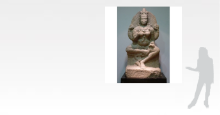
Pallava Dynasty, 9th Century CE
Granite
Height: 44.5 in (113 cm)
Width: 21.5 in (54.6 cm)
REGISTERED ANTIQUITY-NON-EXPORTABLE
Chamundi is one of the Saptamatrikas, or seven holy mothers, whose concept dates back centuries. She is considered an avatar of Kali, or Shakti, and derives her name from slaying the demons Chanda and Munda. Typically, she is depicted as a fierce goddess, with a necklace of skulls in some versions, and with either four, eight, ten or twelve arms in others. Her depiction and attributes highlight her power and her role as the destroyer of all evil.
The lot on offer dates to the Pallava dynasty and shows her in a more benign form. It was perhaps part of an important and magnificent group of Matrikas. Here, Chamundi is shown with four arms and is seated in lalitasana, with one foot folded up. Her right hand is held up, as if to bless those who worship her, and her left arm rests on her lap. Keeping with the stylisation of the Pallava period her ornamentation is simple. She wears a large cylindrical ear-ring in one lobe and the head of a conquered demon in the other. She appears serious: her eyebrows are raised and her expression is demands respect. Her matted hair flows outwards, emphasising her commanding presence. The string of heads that form the yajnopavita, or sacred thread, pass over the forearm.
Despite dating back to the 9th century, the sculpture is intact and in excellent condition. The quality, period, condition and scale make this a significant object.
Numerous sculptures of Chamunda are part of the collections of the British Museum, U.K., the Metropolitan Museum of Art, New York, the Harvard Art Museums, Massachusetts, and the Brooklyn Museum, New York. Sculptures depicting the Matrikas can be seen in the stone carvings at Ellora and Elephanta caves.
The Pallava Dynasty
The Pallava dynasty was a glorious reign that saw a growing patronage of the arts, and churned out many impressive works. They reigned in Kanchipuram in Madras, South India, from the 6th - 9th centuries. They were ruled by King Mahendravarman, a patron of the arts, and their creations were led by the ruler who was himself a sculptor, poet, musician and warrior. His patronage kindled an appreciation in his subjects, who understood and rewarded generations of sculptors.
The sculptures of the Pallavas displayed a characteristic power and dominance - perhaps a reflection of how they viewed themselves. Figures are shown with broad shoulders, heavy chests and serious expressions. These sculptures are said to have a hypnotic effect on the viewer. It is the Pallava School that provided inspiration for the development of the glorious Chola School that followed. Although, the Chola artisans were perfectionists, their art form could not match the strength and the power of the ancient Pallava imagery.
The Pallavas are credited with the earliest cave carvings in South India. Examples of wonderful workmanship still stand as witness to their style, grandeur and artistic creation at Mahabalipuram. Pallava artifacts are difficult to come by, and most of the specimens that still exist have broken or chipped body parts owing to the widespread destruction by invaders.
The National Museum in New Delhi has one of the finest collections of Pallava stone sculptures. Most of the acquisitions were made under the directorship of the late C. Sivaramamurti, one of the most knowledgeable experts in the field of South Indian bronzes and stones.
Other similar works in:
this auction
|
entire site

Lot
28
of
50

LIVE AUCTION: SOUTH ASIAN TREASURES
17 DECEMBER 2014
Estimate
Rs 15,00,000 - 20,00,000
$24,595 - 32,790
Winning Bid
Rs 16,80,000
$27,541
(Inclusive of Buyer's Premium)

Size Size

Height of Figure: 6'